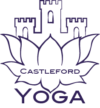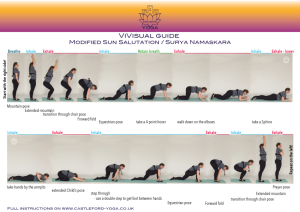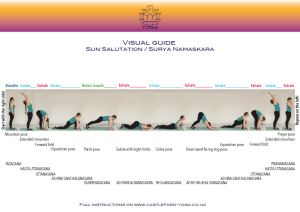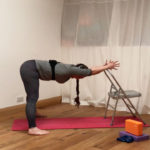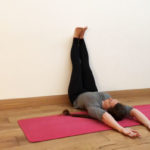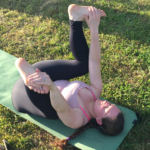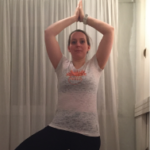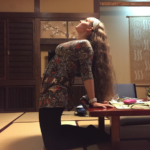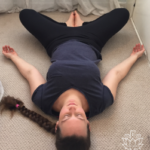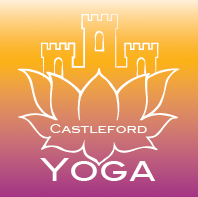
One of the most classic flowing yoga sequences in Yoga is the Sun Salutation. Every yogi should have a go at learning this sequence at some point. It is is a great way to warm, strengthen and stretch the body and even get some cardio training in.
Once you are proficient at the movement patterns and remembering the order of the movements, you can go through the cycle as many times as you like; you’ll find your heart rate picking up just after 1-2 rounds with the large movements using all the muscles which increases the demand of oxygen requiring the heart to pump more blood around the body. You can even work up to doing it the classic 108 times, the number 108 has a significant symbolic meaning not just in Yoga. (Please don’t try to do 108 rounds without building up with regular training, it’s like a yoga marathon.) This is done for purification and it is recommended to only do this with a competent teacher.
For me doing sun salutes or other yoga flows is a much nicer way to get your cardio done then hanging out on the treadmill for ages and you get a nice stretch and tone at the same time. Every muscle in your body has to help make this sequence happen, it’s a full body workout.
I always start with one modified round to get my body into the mood and then increase my range of movement with each round as the body starts feeling more supple.
It is recommended to practice 3-12 rounds slowly for spiritual benefits.
For physical benefits practice 3-12 rounds more swiftly. Beginners should start with 2-3 rounds and add one round every few weeks to avoid premature fatigue.
If you increase the rounds, ensure you are not straining at any point.
Modified Sun Salutation is great for beginners and anyone suffering with aches and back issues.
Click the image, you’ll get a new window with printable PDF document.
Top tip: use a couple of blocks or a few big books to put your hands on in forward fold and equestrian pose, it give you more room around the chest – also for stepping back through to the front.
Improvers Sun Salutation is great for anyone who is reasonably fit and well and want to build some core and upper body strength.
Click the image, you’ll get a new window with printable PDF document.
Work on synchronising your breath with the movement sequence, it helps you breathe deeply and rhythmically which helps increase mental clarity and brings fresh oxygen to the brain.
Note: practice on a fairly empty stomach
Benefits:
- loosens up tension
- stretches the whole body
- massages and tones all the muscles
- moves and mobilises all the joints
- warms the body
- massages the internal organs
- has a vitalising effect on the body
- can balance energy both physical and mentally
- strengthens the back
- helps balance the metabolism
- stimulates balance in: reproductive, circulatory, respiratory and digestive systems
- increase mental clarity
Contra-indication/ and cautious:
- high blood pressure
- coronary artery disease
- anyone who had a stroke
- hernia
- intestinal tuberculosis
- hyper-thyroidism
- back condition – consult with your medical professional first (slipped disc and sciatica should use an alternative asana program)
- do not practice this during menstruation – may resume practice toward the end of the period
- maybe practice with care during pregnancy until 12th week
- may commence practice 40days after giving birth for re-toning the uterine muscles
- knee, ankle and hip problems
Discontinue practice if:
- sudden fever
- acute inflammation
- boils and rashes occur due to excess toxins in the body
- any pain or discomfort in joints or muscles
- head aches
- if you don’t feel good
The order of the poses in written form:
Tadasana – Mountain pose
Before starting the practice, stand with toes together heels slightly apart, and the arms hanging loosely by the side of the body. Give lengths through the back of the body and neck, chin level to the ground and eyes gazing ahead. Find stillness and your breath.
Breathing: slow and aware
Awareness:
Physical – on connecting to the earth and standing tall and strong
Spiritual – on ajna chakra/ third-eye point
Hasta Uttanasana – Extended mountain pose
Raise and stretch both arms above the head with the palms together. Bend the upper body backward from above the bellybutton, you can look up slightly.
Beginners: just raise the arms and leave out the back bend.
Breathing: Inhale while raising the arms.
Awareness:
Physical – on the stretch of the abdomen and expansion of the lungs.
Spiritual – on vishuddhi chakra/ throat region
Uttanasana – Standing forward fold
Bend forward until the fingers or palms of the hands touch the floor on either side of the feet. Make sure you take your pelvis with you, keep pelvis and spine connected, draw the bellybutton to spine to support the back. Work on bringing the forehead toward the knees. Avoid strain. Bend the knees to avoid access pulling in the hamstrings, work on straightening the legs over time as you become more flexible.
Beginners: Sit back into a half squat, place the hands on the thighs, lower the chest to the thighs and then place the hands on the floor bending the knees to make it comfortable. Belly and thighs can tough.
Breathing: Exhale while bending forward.
Awareness:
Physical – on the pelvic region.
Spiritual – on swadhisthana chakra/ Sacral area slightly below the belly button and above the sacrum.
Ashwa Sanchalanasana – Equestrian pose
Place the palms flat on the floor beside the feet. Step the right leg back as far as possible and point the toe. The front leg is now bent, you are in a low kneeling lunge position with full hip, knee and ankle flexion. Keep the arms straight and hands flat on the floor. The weight of the body should be supported on both hands, the front foot, back knee and toes of the foot. Look up and forward, direct the inner gaze to the eyebrow centre.
Breathing: Inhale while stretching the right leg back.
Awareness:
Physical – on the stretch in the front of the thigh or on the eyebrow centre.
Spiritual – on ajna chakra/ third-eye point
Khumbakasana – Plank pose
Tuck the back toes under. Press through both hands whilst stepping back into a plank, keeping the hips level to the ground forming on long line with the body. Use enough core control.
Beginners: take your front leg back so you are in 4 point kneeling – on your hands an knees, keep your back long.
Breathing: Retain/ hold breath while you step the second leg back.
Awareness:
Physical – on the alignment through the whole body, inner strength as well as spiritual alignment and balance
Spiritual – on manipura chakra/ solar plexus area
Ashtanga Namaskara -salute with eight parts or points
Lower the knees, chest and chin to the floor simultaneously. If this is not possible, first lower the knees, then the chest, and finally the chin. The buttocks, hips and abdomen should be raised. In the final position only the toes, knees, chest, hands and chin touch the floor = 8 points.
Beginners: walk down onto your elbows until you lay on your front, snuggle the elbows by the ribcage hands flat just outside the shoulders and forearm on the mat.
Breathing: Exhale as you lower yourself.
Awareness:
Physical – on the abdominal region
Spiritual – on manipura chakra/ solar plexus area
Bhujangasana – cobra pose
from Ashtanga Namaskara lower the body to the floor fully, push gently through the hands and create an even backbend through the back and broaden the chest and gaze ahead. The thighs and hips remain on the floor and the arms support the upper body. Unless the spine is very flexible the arms will remain slightly bent. If you feel discomfort in the small of your back/ lumbar spine squeeze your buttocks it helps support the low back.
Beginners: take a Sphinx pose push yourself up gently through the hands and forearms, drawing the shoulders back and broadening across the chest, gazing ahead keeping the neck long.
Breathing: Inhale while raising the torso and arching the back.
Awareness:
Physical – on relaxation of the spine.
Spiritual – on swadhisthana chakra/ Sacral area slightly below the belly button and above the sacrum.
Adho mukha shvanasana – downward-facing dog Pose
Tuck both toes under whilst pushing back through the palms raisin the buttocks, lowering the head between the arms, pushing the thighs back and the belly toward the thighs. Your back and legs will form two sides of a triangle.
Focus on aligning the arms and torso first, if the legs can not straighten because of tight hamstrings that is ok, you can work on that. Gaze towards the knees. Do not strain.
Beginners: exhale lower from Sphinx pose, inhale take the hands by the armpits, exhale push back into an extended Child’s pose/ Balasana – sit on your heels knees together or apart to make room for the chest, arms outstretched in front, ears are between the upper arms.
Breathing: Exhale while pushing back
Awareness:
Physical – on relaxing the hips or on the throat region.
Spiritual – on vishuddhi chakra/ throat region or on muladhara chakra, located near the basal end of the spinal column (coccyx or butt bone)
Ashwa Sanchalanasana – Equestrian pose
Step the right leg forward between the hands as far as possible – foot flat on the floor. This is now your front leg, you are in a low kneeling lunge position with full hip, knee and ankle flexion. The back leg is long and the foot os pointing back. Keep the arms straight and hands flat on the floor. The weight of the body should be supported on both hands, the front foot, back knee and toes of the foot. Look up and forward, direct the inner gaze to the eyebrow centre.
Beginners: if the foot does not come through between the hands or is not flat on the floor, get hold of the ankle and do another step until you arrive in the full equestrian pose.
Breathing: Inhale while stepping between the hands
Awareness:
Physical – on the stretch in the front of the thigh or on the eyebrow centre.
Spiritual – on ajna chakra/ third-eye point
Uttanasana – Standing forward fold
Step the back leg in to the front leg coming into a forward fold the fingers or palms of the hands touch the floor on either side of the feet. Make sure you take your pelvis with you, keep pelvis and spine connected, draw the bellybutton to spine to support the back. Work on bringing the forehead toward the knees. Avoid strain. Bend the knees to avoid access pulling in the hamstrings, work on straightening the legs over time as you become more flexible.
Breathing: Exhale while bending forward.
Awareness:
Physical – on the pelvic region.
Spiritual – on swadhisthana chakra/ Sacral area slightly below the belly button and above the sacrum.
Hasta Uttanasana – Extended mountain pose
Fold up from the hip and raise/ stretch both arms above the head with the palms together. Bend the upper body backward from above the bellybutton, you can look up slightly. a little back bend.
Beginners: just raise the arms and leave out the back bend.
Breathing: Inhale while raising the arms.
Awareness:
Physical – on the stretch of the abdomen and expansion of the lungs.
Spiritual – on vishuddhi chakra/ throat region
Pranamasana – prayer pose
The final pose and is the same as position as Tadasana. Bring the palms together in front of the chest.
Breathing: Exhale while bring the hands to heart.
Awareness:
Physical – on the region of the heart.
Spiritual – on anahata chakra/ heart region
Repeat on the other side. Always do one starting and finishing with the right leg, and then one for the left leg.
Once you have finished your sun salutation practice, spend a short time Pranamasana/ Prayer pose – appreciating the body supporting you in your yoga practice and in everyday live. Listen the your breath and heat beat and let them slow down to normal.
See if you can practice a few times a week to help you become more confident and comfortable with the sun salutations, observe how it becomes easier and how your confidence grows as your body gets to know the poses and the sequence better each time.
As you practice the meet yourself with kindness, be patient and listen to your body. Take note on which parts of the poses feels challenging. Is it the getting into the pose or the holding? Is it the breath?
Pay attention to your breath, let it be slow and deep as you explore each pose.
As you know, yoga practice should never be painful, if you feel pain, stop. Continuing will not get you any progress because the body will tighten muscles in the area to protect you from injury or aggravation.
It’s ok if the sun salutes are not right for you today, try it again another time when you feel more ready.
Above all make paying attention to your body the primary focus when practicing yoga. Honour your body, it communicates with you constantly – to be well or get well you need to listen and adapt how you treat your body – value and respect your body it’s the only one you have. ( I know I say this often but it is “the most important message” I have for you.)
I hope you love the challenge of using yoga asana poses to get on your cardio and becoming fitter in the process.
Take a moment to think if there is anything you would like to know more about or would like to address, drop me an email and let me know.
I love hearing how you get on with these home practice suggestions.
Namaste
Marie
